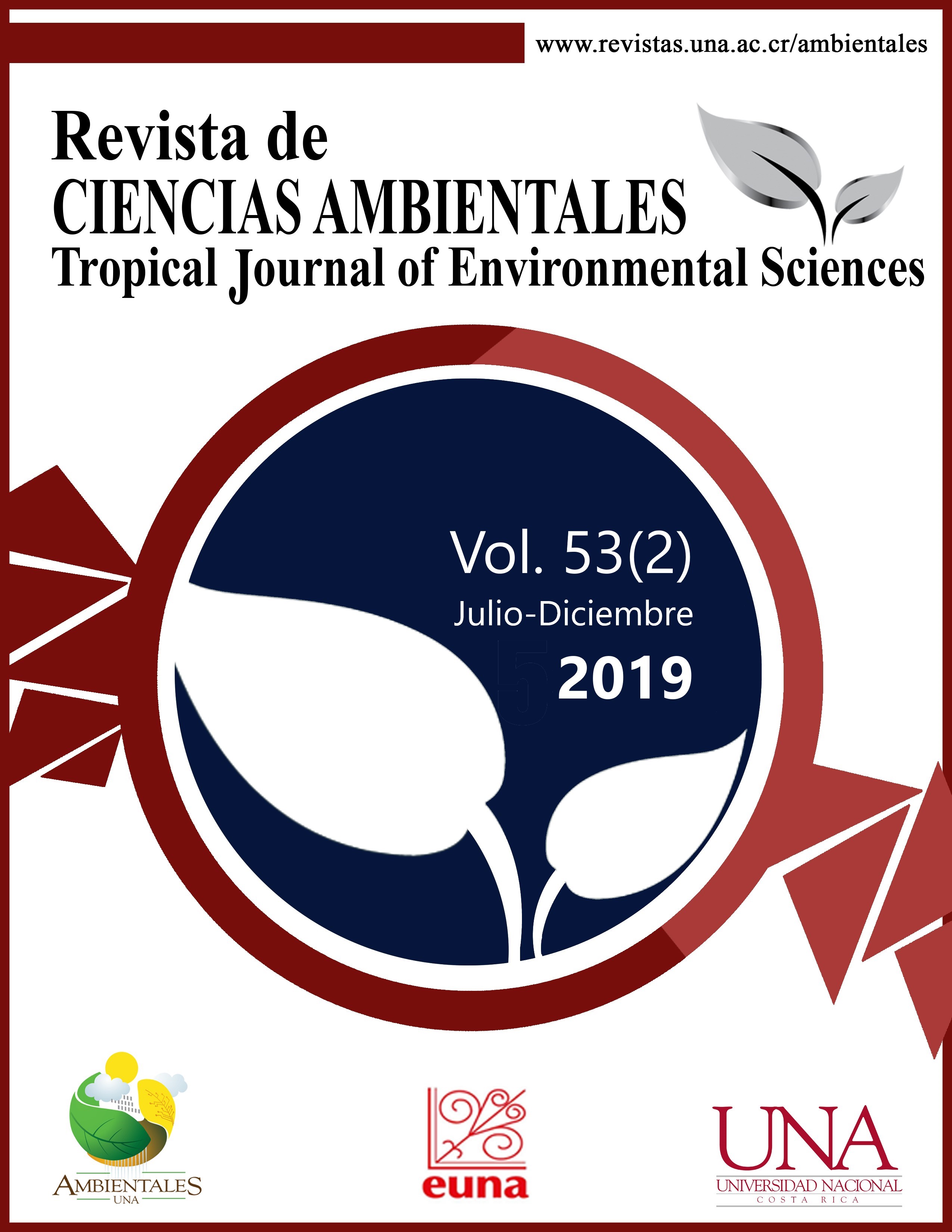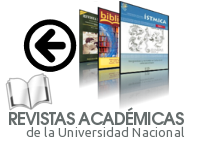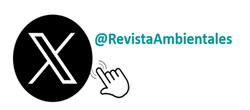Polynomic Behavior of Nitrous Oxide Emission in Coffee Plantations in Costa Rica
DOI:
https://doi.org/10.15359/rca.53-2.1Keywords:
climate change; mitigation, nitrogen; ureaAbstract
Nitrous oxide is a powerful greenhouse gas that is generated both by natural processes and by agricultural practices such as nitrogen fertilization. For this reason, the emission of N2O was quantified by the application of urea nitrogen (0, 100, 225 and 350 kg ha-1 a-1) to coffee plantations in two coffee producing regions of Costa Rica (Valle Occidental and Los Santos). The emission was quantified during an agricultural year. Results showed the effect of rainfall on N2O emission; regardless of the dose, the highest emission occurred during the first days after fertilizer application. In Valle Occidental, the highest emission of N2O was detected with 350 kg of N ha-1 a-1, and intermediate levels with 100 and 225 kg of N ha-1 a-1. The lowest emission was found without fertilization. These results were used to derive a polynomial model (Y=8E-08x3-4E-05x2+0.0064x+0.6266, r2=0.87). In Los Santos, emission was lower without fertilizer; the highest levels were found with 350 kg of N ha-1 a-1. Emissions with 100 and 225 kg of N ha-1 a-1 were similar, although different from the other treatments. A polynomial model was derived using this data (Y=-3E-06x2+0.0023x+0.6347, r2=0.87). With the data of both localities a polynomial model was derived (Y=6E-08x3–3E-05x2+0.0052x+0.6247, r2=0.83). Use of this information is recommended to estimate the N2O generated by urea application to coffee plantations.
References
Alvarado, A., Bertsch, F., Bornemisa, E., Cabalceta, G., Forsythe, W., Henríquez, C., Mata, R., Molina, E. y Salas, R. (2001). Suelos derivados de cenizas volcánicas (Andisoles) de Costa Rica. Costa Rica: Asociación Costarricense de la Ciencia del Suelo ACCS.
Araújo, D. (2016). Emissoes de gases de efeito estufa por fertilizantes nitrogenados em lavoura cafeeira irrigada. Tesis, Universidade Federal de Lavras, 128 p.
Butterbach-Bahl, K., Baggs, E., Dannenmann, M., Kiese, R. and Zechmeister-Boltenstern, S. (2013). Nitrous oxide emissions from soils: how well do we understand the processes and their controls? Philosophical Transactions of the Royal Society of London. Series B, Biological Sciences, 368. https://doi.org/10.1098/rstb.2013.0122
Chaves-Arias, V. (2012). Fertilización y encalado del cultivo de café, con base al análisis químico de suelos. Costa Rica: ICAFE.
Chinchilla, M., Mata, R. y Alvarado, A. (2011). Caracterización y clasificación de algunos ultisoles de la región de Los Santos, Talamanca, Costa Rica. Agronomía Costarricense, 35(1), 59-81.
Davidson, E. and Kanter, D. (2014). Inventories and scenarios of nitrous oxide emissions. Environmental Research Letters, 9. https://doi.org/10.1088/1748-9326/9/10/105012
Di Rienzo J., Casanoves F., Balzarini M., Gonzalez L., Tablada M. y Robledo C. (2015). InfoStat versión 2015. Grupo InfoStat, FCA, Universidad Nacional de Córdoba, Argentina. Disponible en: http://www.infostat.com.ar
Grant, R., Pattey, E., Goddard, T., Kryzanowski, L. and Puurveen, H. (2006). Modeling the effects of fertilizer application rate on nitrous oxide emissions. Soil Sci. Soc. Am. J., 70, 235-248. https://doi.org/10.2136/sssaj2005.0104
Hénault, C., Grossel, A., Mary, B., Roussel, M., and Léonard, J. (2012). Nitrous oxide emission by agricultural soils: A review of spatial and temporal variability for mitigation. Pedosphere 22(4), 426-433. https://doi.org/10.1016/S1002-0160(12)60029-0
Hergoualc’h, K., Blanchart, E., Skiba, U., Hénaultf, C., Harmand, J. (2012). Changes in carbon stock and greenhouse gas balance in a coffee (Coffea arabica) monoculture versus an agroforestry system with Inga densiflora, in Costa Rica. Agriculture, Ecosystems and Environment, 148, 102–110. https://doi.org/10.1016/j.agee.2011.11.018
Hergoualc’h, K., Skiba, U., Harmand, J. and Hénault, C. (2008). Fluxes of greenhouse gases from andosols under coffee in monoculture or shaded by Inga densiflora in Costa Rica. Biogeochemistry, 89, 329-345. https://doi.org/10.1007/s10533-008-9222-7
Hergoualc’h, K., Skiba, U., Harmand, J. and Olivier, R. (2007). Processes responsible for the nitrous oxide emission from a Costa Rican Andosol under a coffee agroforestry plantation. Biol Fertil Soils, 43,787-795. https://doi.org/10.1007/s00374-007-0168-z
Hoben, J., Gehl, R., Millar, N., Graces, P. and Robertson, P. 2011. Nonlinear nitrous oxide (N2O) response to nitrogen fertilizer in on-farm corn crops of the US Midwest. Global Change Biology, 17, 1140-1152. https://doi.org/10.1111/j.1365-2486.2010.02349.x
Holdridge, L. (1979). Ecología basada en zonas de vida. Costa Rica: Instituto Interamericano de Ciencias Agrícolas.
IPCC (Intergovermental Panel on Climate change). (2006). Guidelines for National Greenhouse Gas Inventories. Japan: National Greenhouse Gas Inventories Programme.
Kim, D., Hernandez, G. and Giltrap, D. (2013). Linear and nonlinear dependency of direct nitrous oxide emissions on fertilizer nitrogen input: A meta-analysis. Agriculture, Ecosystems and Environment, 168, 53-65. https://doi.org/10.1016/j.agee.2012.02.021
Linn, D. and Doran, J. (1984). Effect of water-filled pore space on carbon dioxide and nitrous oxide production in tilled and nontilled soils. Soil Science Society of America Journal, 48, 1267-1272. https://doi.org/10.2136/sssaj1984.03615995004800060013x
Montenegro, J. (2012). Respuesta no lineal de la emisión de óxido nitroso a cantidades crecientes de nitrógeno en gramíneas bajo pastoreo en el sistema de producción de leche en Costa Rica. Tópicos Meteorológicos y Oceanográficos, 11, 44-51.
Montenegro, J. (2013). El cambio climático en el sector agropecuario costarricense. Contribuyendo con la mitigación. Costa Rica: INTA/IMN.
Montenegro, J.; Abarca, S. (2001). Importancia del sector agropecuario costarricense en la mitigación del calentamiento global. Ministerio de Agricultura y Ganadería, Instituto Meteorológico Nacional. 96 p.
Montenegro, J. y Herrera, J. (2013). Emisión de óxido nitroso (N2O) en el sistema de producción café sin sombra en Costa Rica. Tópicos Meteorológicos y Oceanográficos, 12, 22-34.
Pires M., da Cunha, D., de Matos, C. y Costa, M. (2015). Nitrogen-use efficiency, nitrous oxide emissions, and cereal production in Brazil: Current trends and forecasts, PLoS ONE, 10(8), e0135234. https://doi.org/10.1371/journal.pone.0135234
Rochette, P. (2011). Towards a standard non-steady-state chamber methology for measuring soil N2O emissions. Animal Feed Science and Technology, 166-167, 141-146. https://doi.org/10.1016/j.anifeedsci.2011.04.063
Scheer, C., Rowlings, D. and Grace, P. (2016). Non-linear response of soil N2O emissions to nitrogen fertiliser in a cotton–fallow rotation in sub-tropical Australia, Soil Research, 54, 494-499. https://doi.org/10.1071/SR14328
Schwenke, G., Haigh, B. (2016). The interaction of seasonal rainfall and nitrogen fertiliser rate on soil N2O emission, total N loss and crop yield of dryland sorghum and sunflower grown on sub-tropical Vertosols. Soil Research, 54, 604–618. https://doi.org/10.1071/SR15286
Shcherbak, I., Millar, N. and Robertson, G. (2014). Global metaanalysis of the nonlinear response of soil nitrous oxide (N2O) emissions to fertilizer nitrogen. PNAS, 111(25): 9199-9204. https://doi.org/10.1073/pnas.1322434111
Van Groenigen, J., Velthof, G., Oenema, O., Van Groenigen, K. and Van Kessel, C. (2010). Towards an agronomic assessment of N2O emissions: a case study for arable crops. European Journal of Soil Science, 61, 903-913. https://doi.org/10.1111/j.1365-2389.2009.01217.x
Wang, W., Park, G., Reeves, S., Zahmel, M., Heenan, M. and Salter, B. (2016). Nitrous oxide emission and fertiliser nitrogen efficiency in a tropical sugarcane cropping system applied with different formulations of urea. Soil Research, 54, 572-584. https://doi.org/10.1071/SR15314
Zebarth, B., Rochette, P. and Burton, D. (2008). N2O emissions from spring barley production as influenced by fertilizer nitrogen rate. Can. J. Soil Sci., 88, 197-205. https://doi.org/10.4141/CJSS06006
Zhou, W., Ji, H., Zhu, J., Zhang,Y., Sha, L., Liu, Y., Zhang, X., Zhao, W., Dong, Y., Bai, X., Lin, Y., Zhang, J. and Zheng, X. (2016). The effects of nitrogen fertilization on N2O emissions from a rubber plantation. Nature. Scientific Reports, 6, 28230. https://doi.org/10.1038/srep28230
Downloads
Published
How to Cite
Issue
Section
License

This work is licensed under a Creative Commons Attribution-NonCommercial-ShareAlike 4.0 International License.



















